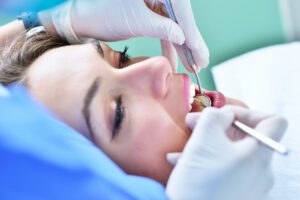
There are two words related to oral health that you should think of as the dangerous duo plaque and tarter. Together, they work to wreak havoc in your mouth, causing gum disease, tooth decay, and teeth stains. They can be defeated by the superheroes of oral health your toothbrush and floss – but if you skip using them, you’ll more than likely get to know them personally as the dangerous duo.
An Inside Look at the Dangerous Duo
The more you know about plaque and tartar, the better your odds of winning the oral health war. So what is plaque? It’s a colorless, sticky layer of bacteria and sugars that constantly forms on your teeth. It’s the leading cause of gum disease and cavities, and if you don’t remove it daily, its buddy tartar will arrive. You can’t avoid plaque since bacteria are constantly forming in our mouths. These bacteria feed on ingredients in your diet and saliva to grow. Plaque creates acids, which attack your teeth after you eat and eventually cause cavities. That happens because the repeated acid attacks break down your tooth enamel and a cavity may form. Also, if you don’t get rid of the plaque, it can irritate the gums around your teeth, leading to gingivitis (red, swollen, bleeding gums), periodontal disease and tooth loss.
And what is tartar? Again, it is plaque that had hardened onto your teeth and become a mineral. It is also called calculus. It is fairly easy to spot when it’s above your gumline because it will create a yellow or brown color on your teeth or gums. Tartar can also form at and underneath the gumline and can irritate gum tissues. It provides a fertile breeding ground for additional plaque to adhere and eventually turn to tartar. Plus, your teeth will get stained more easily because tartar is porous and absorbs stains from beverages like coffee or tea.
Stopping the Dangerous Duo From Gaining Traction
If you’ve let plaque turn into tartar in your mouth, there isn’t much you can do except visit your dentist at Personal Care Dentistry. But you can prevent plaque by using the superheroes of oral health on a daily basis. That means brushing twice a day and flossing daily. In addition, you can have an even better chance to win the battle against plaque by watching what you eat.
Personal Care Dentistry suggests this game plan for taking on plaque and tartar:
Be sure to brush at least twice a day with fluoridated toothpaste to get rid of plaque from all of your teeth’s surfaces. Don’t scrub hard back and forth when you brush. Instead, use small circular motions combined with short back and forth motions.
Use your floss each day to remove plaque from between your teeth and under your gumline, (where your toothbrush may not reach). Remember to ease the floss between your teeth. Snapping it into place may damage your gums. The best time to floss is before you go to bed.
Another way of removing plaque between teeth is to use a dental pick a thin plastic or wooden stick. These sticks can be purchased at drug stores and grocery stores.
Limit sugary or starchy foods, especially sticky snacks. Food residues, especially sweets, provide nutrients for the germs that cause tooth decay, as well as those that cause gum disease. So less is better when it comes to sweets.
How Do I Know If I Have Plaque?
Dental plaque is difficult to see unless it’s stained. You can stain plaque by chewing red “disclosing tablets,” found at grocery stores and drug stores, or by using a cotton swab to smear green food coloring on your teeth. The red or green color left on the teeth will show you where there is still plaqueand where you have to brush again to remove it. Stain and examine your teeth regularly to make sure you are removing all plaque.
How Is Tartar Removed by a Dentist?
Once tartar has formed, only your dentist or hygienist can remove it. The process for removing tartar is called scaling. During a scaling, the hygienists at Personal Care Dentistry use special instruments to remove tartar from your teeth above and below the gumline.
Sources: National Institute of Dental and Craniofacial Research; American Dental Association; Colgate-Palmolive, Inc.


